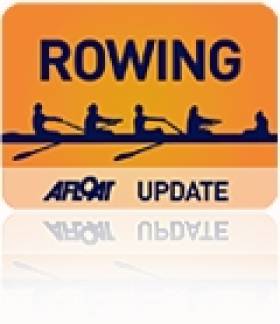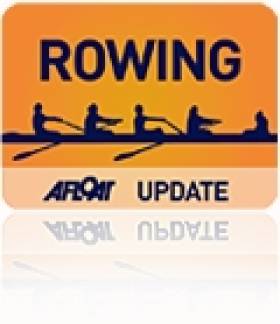Displaying items by tag: League,
Skibbereen Win eFlow Grand League Rowing Series
#ROWING: Skibbereen Rowing Club are the eFlow Go Row League champions of 2012. The west Cork club amassed 466 points over the three rounds and won Division One for men and for women.
All three regattas which hosted the eFlow League had huge entries. Skibbereen Rowing Club held the first regatta of the series at the National Rowing Centre in April and had 560 entries, becoming the biggest one-day regatta ever held in Ireland. Queen’s University staged the second round at Castlewellan and Cork Regatta at the NRC last weekend was the final in the series. Metropolitan Regatta at Blessington Lakes, which would have been the third round, had to be cancelled because of high winds.
“We’re very pleased to have won,” said Dominic Casey, the head coach of Skibbereen. “I think the league is good for rowing. The entry speaks for itself.”
There are prizes of €400 for each division winner and €400 to the overall points leader.
Casey’s club was taking its third League title in succession. This season they were pushed hard by Queen’s University in the men’s class (192 points to 172), while Three Castles, who are based at Blessington, were second in women’s Division One. Lee won men’s Division Two and Commercial of Dublin took women’s Division Two.
eFlow Go Row League 2012
Overall: 1 Skibbereen RC 466, 2 Lee RC 303, 3 St Michael’s RC 296, 4 Cork BC 270, 5 UCD BC 267, 6 NUIG BC 259, 7 Queen’s BC 255, 8 Dublin University BC 208, 9 Commercial RC 208, 10 Shandon BC 204.
Men – Division One: 1 Skibbereen 192, 2 Queen’s 172, 3 NUIG 114, 4 St Michael’s 89, 5 Bann 73, 6 Cork 59. Division Two: 1 Lee 225, 2 Queen’s 83, 3 Skibbereen 77.
Women – Division One: 1 Skibbereen 188, 2 Three Castles RC 139, 3 St Michael’s 119, 4 Queen’s LBC 88, 5 Cork 86, 6 NUIG 74. Division Two: 1 Commercial 109, 2 Queen’s LBC 88, 3 Dublin University LBC 76.
Dukarska Comes Out on Top in Battle With Nixon
#ROWING: Monika Dukarska and Holly Nixon engaged in an entertaining battle in the women’s single sculls at Queen’s University Regatta at Castlewellan today, with Dukarska coming out on top in the closing stages. Helen Walshe, who won the first round of the eFlow Go Row League, was third, and Sinead Jennings fourth. Colin Williamson won the men’s equivalent. Queen’s won the Division One men’s eight. Galway Rowing Club finished second, beating Bann and Methodist College in the battle of the junior eights. Skibbereen won the women’s eight.
Queen’s University Regatta, Castlewellan – Selected Results
First Session
Men
Eight - Division Two – A Final: 1 Queen’s (novice) 5:37.23, 2 Neptune (jun) 5:40.85, 3 Methody (jun) 5:50.92. B Final: Neptune (jun 16) 5:59.44.
Four, coxed – Division One – A Final: Queen’s (sen) 5:43.38, 2 Bann (inter) 5:47.25, 3 Methody (jun) 5:51.66.
Pair – Division One – A Final: 1 Bann (J Cassells, C Black; jun) 5:59.41, 2 Portora (jun) 6:06.41, 3 Queen’s (sen) 6:08.41. B Final: Queen’s (sen) 6:32.56; 3 Commercial 6:44.56.
Sculling, Single – Division One – A Final: 1 Queen’s (C Williamson, sen) 6:12.03, 2 UCD (D Neale) 6:16.04, 3 Skibbereen (A Burns; jun) 6:17.79, 4 Neptune (Bailey, inter) 6:20.14. B Final: 1 Queen’s (McKibbin, sen) 6:26.59; 3 RBAI (Beck, lightweight) 6:30.32. C Final: Shandon (Casey; jun) 6:27.95.
Division Two – A Final: 1 Lee (Twomey-Thompson, jun) 7:20.75, 2 RBAI (McKillan; jun) 7:24.25, 3 Skibbereen (Keating; jun 16) 7:26.80. B Final: (O’Sullivan; jun 16) 6:26.59. C Final: Offaly (Gannon; nov) 7:32.09.
Women – Eight – Division One – A Final (aggregated result from two races): 1 Skibbereen (sen) 5:47.87, 2 Galway (jun) 5:56.36, 3 St Michael’s (jun) 5:58.87.
Four, coxed – Division One – A Final: 1 Commercial (inter), 2 Queen’s, 3 Belfast. Division Two, coxed – Final: 1 Queen’s (nov) 6:53.80, 2 Belfast BC (nov) 7:02.08, 3 Commercial (nov) 7:23.12.
Sculling, Quadruple – Division One A Final: 1 Three Castles (sen) 5:59.66, 2 Portora/Belfast/Fermoy/Skibbereen (sen) 6:06.91, 3 Shandon (jun) 6:18.40. B Final: Skibbereen (jun) 6:17.49. Division Two, coxed – A Final: 1 Galway (jun 16) 6:43.76, 2 Killorglin (jun 16) 6:48.17, 3 St Michael’s (jun 16) 7:01.14. B Final: Athlunkard (nov) 7:09.56.
Double – Division One – A Final: 1 Skibbereen (D Walsh, M Dineen; sen) 6:47.80, 2 Skibbereen (sen) 6:55.87, 3 Three Castles (sen) 6:56.24; 4 Neptune (jun) 7:11.52. B Final: 1 Carrick-on-Shannon (jun) 7:33.88, 2 Garda (inter) 7:39.54.
Division Two – A Final: 1 Muckross (jun 16) 7:18.96, 2 S Michael’s (jun 16) 7:27.63, 3 Commercial (jun 18) 7:35.06; 5 Queen’s (nov) 7:44.70. B Final: Lee (jun 18) 7:29.14.
(Second session; run on Time Trial Basis)
Men
Eight – Division One: 1 Queen’s (senior) 4:40.74, 2 Galway (junior) 4:45.74, 3 Bann (jun) 4:48.25; 4 Methodist College, Belfast (jun) 4:50.19, 5 Queen’s (intermediate) 5:08.80, 6 Queen’s B (inter) 5:12.65.
Fours – Division One: 1 Bann/Portora (sen) 5:04.80, 2 Queen’s 5:14.46, 3 Methody 5:38.27. Fours, coxed – Division Two: 1 Queen’s (nov) 5:38.95, 2 UCD (nov) 5:55.15, 3 UCD (nov) 6:00.05; 5 Methody (jun) 6:06.41; 6 Commercial (jun 16) 6:14.22.
Sculling, Quadruple – Division One: 1 Queen’s (sen) 5:07.78, 2 Skibbereen (jun) 5:16.68, 3 Bann (inter) 5:19.25. Division Two (coxed): 1 Neptune (jun 16) 5:44.06, 2 Galway (jun 16) 5:48.71, 3 Commercial (jun) 6:00.09; 5 Athlunkard 6:04.40. Double – Division One: 1 Queen’s (sen) 5:32.40, 2 Shandon (jun) 5:39.50, 3 Skibbereen (jun) 5:40.65; 5 Garda 5:41.46. Division Two 1 Lee (jun 16) 5:55.38, 2 Lee B (jun 18) 5:59.18, 3 Skibbereen (jun 16) 6:07.36; 6 Galway (nov) 6:15.90.
Women
Eight – Division Two: 1 Queen’s (nov) 5:59.63, 2 Athlunkard (nov) 6:21.24, 3 Shannon (nov) 6:29.83; 4 Methody (jun 16) 6:39.25; 6 Shannon 7:03.44.
Four – Division One: 1 Queen’s (sen) 5:58.49, 2 Skibbereen (sen) 6:06.54, 3 Bann/St Michael’s (sen) 6:12.98; 4 Muckross (jun) 6:14.03.
Sculling,
Single – Division One: 1 Killorglin (M Dukarska; sen) 6:24.17, 2 Portora (H Nixon; sen) 6:24.88, 3 Three Castles (H Walshe; sen) 6:36.41; 4 St Michael’s (Jennings; sen) 6:44.42, 5 Three Castles (B Quinn; lwt) 6:49.76, 6 Fermoy (H Shinnick; jun) 7:03.23; 11 Queen’s (Addley; inter) 7:20.54. Division Two: 1 Queen’s (Richards; nov) 7:55.56, 2 Methody (English; jun 16) 8:01.29, 3 St Michael’s (Sherin, jun) 8:06.93.
Skibbereen Top First Rankings In eFlow Go Row League
#ROWING: Skibbereen stand on top of the first eFlow Go Row League Table today. The club, which won the league last year, leads from NUIG and Cork Boat Club after the Skibbereen Regatta.
| eFlow 'GoRow' Grand League Series 2012 | ||
|---|---|---|
| Overall Points Table | ||
| Rank | Club | Points |
| 1 | Skibbereen RC | 181 |
| 2 | NUIG BC | 140 |
| 3 | Cork BC | 140 |
| 4 | Lee RC | 119 |
| 5 | UCD BC | 109 |
| 6 | St. Michael's RC | 109 |
| 7 | QUBBC | 80 |
| 8 | Shandon BC | 69 |
| 9 | DULBC | 68 |
| 10 | QUBLBC | 60 |
| 11 | Fermoy RC | 55 |
| 12 | University of Limerick RC | 51 |
| 13 | Three Castles | 51 |
| 14 | Galway RC | 50 |
| 15 | DUBC | 46 |
| 16 | Commercial RC | 42 |
| 17 | Carlow | 40 |
| 18 | Shannon RC | 34 |
| 19 | Garda BC | 28 |
| 20 | Presentation College Cork | 27 |
| 21 | Lee Valley RC | 24 |
| 22 | Athlone BC | 21 |
| 23 | UCC RC | 20 |
| 24 | Castleconnell RC | 19 |
| 25 | Clonmel RC | 18 |
| 26 | Cappoquin RC | 16 |
| 27 | Neptune RC | 14 |
| 28 | Athlunkard BC | 13 |
| 29 | Gráinne Mhaol RC | 11 |
| 30 | Killorglin RC | 11 |
| 31 | St. Joesph's RC | 7 |
| 32 | Blackrock College RC | 5 |
| 33 | Coláiste Chiaráin | 3 |
| 34 | Waterford BC | 1 |


























































